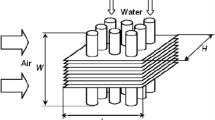Abstract
In this study, a radial heat sink with a concentric cylinder and triangular fins installed on a circular base, that is, a heat sink representing a general shape of the heat sinks employed for most of the commercial LED light bulbs, was optimized in terms of mass and thermal resistance. A numerical study was performed by considering natural convection and radiation heat transfer, and was validated through experiment. The effects of various geometric parameters, that is, radius of heat sink base, number of fins, fin height, and radius of hollow cylinder, on thermal resistance and convectional heat transfer coefficient were investigated. Multiobjective optimization was conducted by using the weighted sum method and the genetic algorithm. As a result, Pareto fronts were obtained, and the thermal resistance and mass of the radial heat sink with triangular fins were reduced compared to those of the reference radial heat sink.
Similar content being viewed by others
References
A. Christensen and S. Graham, Thermal effects in packaging high power light emitting diode arrays, Applied Thermal Engineering, 29 (2) (2009) 364–371.
E. Sparrow and S. Vemuri, Orientation effects on natural convection/radiation heat transfer from pin-fin arrays, International Journal of Heat and Mass Transfer, 29 (3) (1986) 359–368.
M. Iyengar and A. Bar-Cohen, Least-material optimization of vertical pin-fin, plate-fin, and triangular-fin heat sinks in natural convective heat transfer, The Sixth Intersociety Conference on IEEE Thermal and Thermomechanical Phenomena in Electronic Systems, ITHERM'98 (1998) 295–302.
S. Baskaya, M. Sivrioglu and M. Ozek, Parametric study of natural convection heat transfer from horizontal rectangular fin arrays, International Journal of Thermal Sciences, 39 (8) (2000) 797–805.
C. Kobus and T. Oshio, Development of a theoretical model for predicting the thermal performance characteristics of a vertical pin-fin array heat sink under combined forced and natural convection with impinging flow, International Journal of Heat and Mass Transfer, 48 (6) (2005) 1053–1063.
J. Lee, K. Rew, C. Lee, D. Kim and M. Kim, A study on heatsink fin wave optimization for climate control seat, Journal of Mechanical Science and Technology, 31 (3) (2017) 1489–1495.
A. Shadlaghani, M. R. Tavakoli, M. Farzaneh and M. R. Salimpour, Optimization of triangular fins with/without longitudinal perforate for thermal performance enhancement, Journal of Mechanical Science and Technology, 30 (4) (2016) 1903–1910.
M. Mardani and M. R. Salimpour, Optimization of triangular microchannel heat sinks using constructal theory, Journal of Mechanical Science and Technology, 30 (10) (2016) 4757–4764.
S. H. Yu, K. S. Lee and S. J. Yook, Natural convection around a radial heat sink, International Journal of Heat and Mass Transfer, 53 (13) (2010) 2935–2938.
V. A. Costa and A. M. Lopes, Improved radial heat sink for led lamp cooling, Applied Thermal Engineering, 70 (1) (2014) 131–138.
S. J. Park, D. Jang, S. J. Yook and K. S. Lee, Optimization of a staggered pin-fin for a radial heat sink under free convection, International Journal of Heat and Mass Transfer, 87 (2015) 184–188.
S. J. Park, D. Jang, S. J. Yook and K. S. Lee, Optimization of a chimney design for cooling efficiency of a radial heat sink in a LED downlight, Energy Conversion and Management, 114 (2016) 180–187.
B. Li and C. Byon, Orientation effects on thermal performance of radial heat sinks with a concentric ring subject to natural convection, International Journal of Heat and Mass Transfer, 90 (2015) 102–108.
B. Li, Y. J. Baik and C. Byon, Enhanced natural convection heat transfer of a chimney-based radial heat sink, Energy Conversion and Management, 108 (2016) 422–428.
B. Li, S. Jeon and C. Byon, Investigation of natural convection heat transfer around a radial heat sink with a perforated ring, International Journal of Heat and Mass Transfer, 97 (2016) 705–711.
M. Lee, H. J. Kim and D. K. Kim, Nusselt number correlation for natural convection from vertical cylinders with triangular fins, Applied Thermal Engineering, 93 (2016) 1238–1247.
Y. A. Cengel and A. J. Ghajar, Heat and Mass Transfer: Fundamentals and Applications, Fifth Ed., McGraw-Hill, Singapore (2015).
R. S. Figliola and D. Beasley, Theory and design for mechanical measurements, Fifth Ed., John Wiley & Sons, New York, USA (2011).
A. D. Belegundu and T. R. Chandrupatla, Optimization concepts and applications in engineering, Second Ed., Cambridge University Press, New York, USA (2011).
Author information
Authors and Affiliations
Corresponding author
Additional information
Recommended by Associate Editor Ji Hwan Jeong
Dong-Bin Kwak received the B.S. degree from the School of Mechanical Engineering, Hanyang University, Republic of Korea, in 2017. He is currently a Ph.D. student at the Department of Mechanical Engineering, University of Minnesota, USA. His research interests include heat transfer and aerosol technology.
Hoon-Pyo Kwak received the B.S. degree from the Department of Mechanical Engineering, Myongji University, Republic of Korea, in 2010, and the M.S. degree from the Department of Mechanical Convergence Engineering, Hanyang University, Republic ore Korea, in 2016. His research interests include thermo-flow modeling.
Jung-Hun Noh received the B.S. degree from the School of Mechanical Engineering, Hanyang University, Republic of Korea, in 2010, and the Ph.D. degree from the Department of Mechanical Convergence Engineering, Hanyang University, Republic ore Korea, in 2017. His research interest includes heat transfer.
Se-Jin Yook received the B.S. degree from the School of Mechanical Engineering, Hanyang University, Republic of Korea, in 2000, and the Ph.D. degree from the Department of Mechanical Engineering, University of Minnesota, USA, in 2007. He is currently an Associate Professor at the School of Mechanical Engineering, Hanyang University, Republic of Korea. His research interests include heat transfer and aerosol technology.
Rights and permissions
About this article
Cite this article
Kwak, DB., Kwak, HP., Noh, JH. et al. Optimization of the radial heat sink with a concentric cylinder and triangular fins installed on a circular base. J Mech Sci Technol 32, 505–512 (2018). https://doi.org/10.1007/s12206-017-1252-4
Received:
Revised:
Accepted:
Published:
Issue Date:
DOI: https://doi.org/10.1007/s12206-017-1252-4




